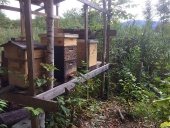So soon I am going to come into some bees, and though i have read a decent bit on the subject, i have no experience yet...whats more the folks providing us with the nuc are only in their second year of beekeeping.
What follows is a quick conversation I had with Tel..
me: "I have read alot of your posts on beekeeping. So here's the deal: A friend of the family has offered to get me started in beekeeping this may.I was not planning on taking the leap until next year. Full setup provided; except protective gear.I live in east texas (zone 8 / 9a), It gets very hot in the summer. I believe they are providing us with a langstroth hive
All of that being said, i have a nice semi shady spot which I was going to build a new
compost pile in before this offer came around. It is sheltered on three sides by trees and brush; would this be a good placement? Should i cover the hive during rainstorms? They have mentioned sugar water.....should i be feeding the bees, and if so for how long?
Any and all help or advice you can offer would be greatly appreciated!"
Tel: " first things first: all beekeeping is local. that is to day that my experience keeping bees in Washington State might not qualify me to give advice to somebody in Texas. but you asked, so I'll give it a try.
a shady spot does sound like a good idea. providing access to water would probably also be wise, as they can use water to cool the hive via evaporation. that could be as simple as a pie tin with some rocks in it that you keep partly filled with water. the main idea is to prevent drowning the bees by either avoiding standing water or providing an exit if they do end up floating.
feeding: I don't do it and I don't think it's a good idea but for a few very specific cases. were they suggesting feeding this Spring or some other time? if you've just got one hive and it doesn't seem like they've got enough reserves to make it through the Winter, feeding in the Fall might make sense for some folks. my personal approach is to let colonies do what they will. if they starve over the Winter, it's likely they weren't adapted well to local conditions.
if you do end up with Lang equipment, consider modifying it to run as a vertical top bar hive. I believe frames are one of the more pernicious scourges of modern beekeeping.
and don't be shy about posting in the forum. other folks will have other ideas and knowledge that might come from conditions more similar to yours than mine are. and other folks could benefit from reading the answers you get and the further questions that are generated.
tel"
me: " Thank you for your input! After speaking with the lady this morning, she and her husband are going to provide us with a top bar hive. " and don't be shy about posting in the forum"...
With your permission I'll gladly repost our conversation thus far."
Tel: " top bar hive sounds great. I've not had great experiences with horizontal top bar hives here in Washington, but I've heard a lot of good things from drier parts of the world.
go ahead and post it on the forum."
Mkay... so folks this is where I stand: I have an outfit and smoker ordered; buckwheat seed ordered ( and 1/2 acre to plant it), and in 2 months a top bar hive and a nuc with a queen....dont forget to breathe...
Anyone who wants - feel free to throw out do's and dont's!

For water i have a small pond about 300 ft from where i plan to place the hive, and I asked for clarification on feeding; she said for a couple weeks until they are established in their new home.





 For water i have a small pond about 300 ft from where i plan to place the hive, and I asked for clarification on feeding; she said for a couple weeks until they are established in their new home.
For water i have a small pond about 300 ft from where i plan to place the hive, and I asked for clarification on feeding; she said for a couple weeks until they are established in their new home.




















 for the rest of the growing season we have a small orchard and lots of wildflowers, with a smattering of flowering dogwoods. I own 5 acres; most of it wild, thick growth, so I don't think they will have a shortage of choices.
for the rest of the growing season we have a small orchard and lots of wildflowers, with a smattering of flowering dogwoods. I own 5 acres; most of it wild, thick growth, so I don't think they will have a shortage of choices.







 1
1

























































